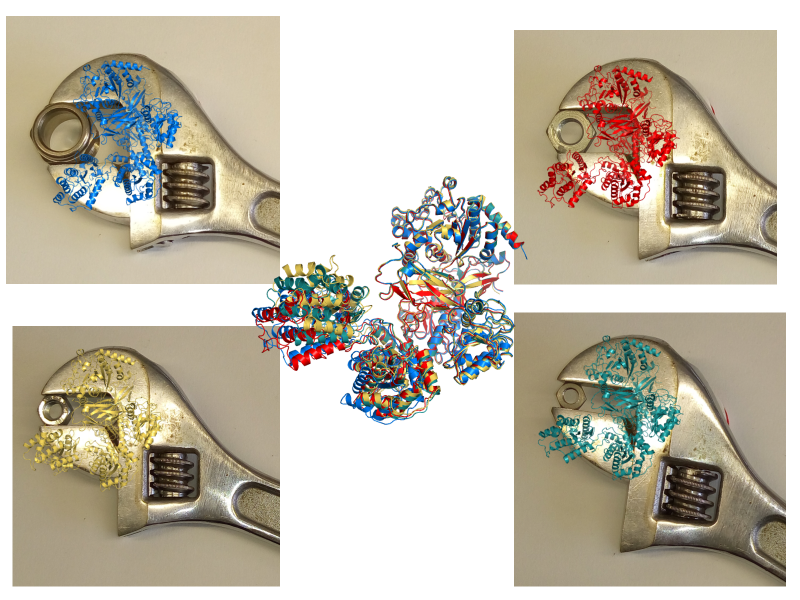Checking the checkpoint: Revealing the structure of an elusive quality control enzyme
The structure of an important enzyme that oversees the secretion of thousands of secreted glycoproteins has been solved by a fruitful collaborative effort between the Department of Biochemistry and Diamond Light Source in Oxford, and two Italian research institutes, the Institute of Sciences of Food Production in Lecce and the Institute of Crystallography at the National Research Council in Bari. The study, recently published in PNAS, found that the enzyme had previously unsuspected flexibility that allowed it to adapt its conformation and clasp its many different client glycoproteins.
Glycoproteins make up a huge proportion of the protein content of cells. The majority of secreted proteins are glycosylated and even viruses hijack this pathway to be folded correctly to spread their infection. The critical governor of the folding quality of glycoproteins is UGGT, a 170 kDa enzyme that is found in all eukaryotes, from yeast to fish to birds and mammals. UGGT acts as the gatekeeper for glycoproteins by flagging any that are misfolded and preventing their premature release from the endoplasmic reticulum. The tag for retention is a glucose moiety that UGGT sticks onto the glycan on any misfolded glycoprotein. Although UGGT is widespread, its structure and function has eluded scientists for 25 years. Its intriguing promiscuity for checking thousands of glycoproteins of different shapes and sizes has attracted much attention.
Drawn to the challenge, a concerted effort was made by academics at the University of Oxford and the National Research Council of Italy, along with staff at Diamond, to finally determine the structure and solve the mystery of this enigmatic enzyme. The structure was solved with the aid of the Macromolecular Crystallography beamline (I04-1) and cryo-electron microscopy (EM) at the state-of-the-art Electron Bio-Imaging Centre (eBIC) at Diamond Light Source. Lead scientist of the joint effort and research scientist here in the Department, Dr Pietro Roversi, explained their motivation: "We wanted to know how UGGT could be in charge of checking the correctness of folded proteins given that they all so different. There are some very important targets of UGGT, including immunological proteins and those that are retained in rare congenital diseases."

Illustration demonstrating the conformational flexibility of UGGT and its ability to clasp different sized client glycoproteins
It is now clear that one of the reasons why the structure of UGGT had eluded scientists for so long was because of its flexibility. Indeed, the enzyme crystallises in three different conformations. To overcome this hurdle, the team wisely chose to study a form of UGGT derived from a thermophilic fungus. Proteins from heat-resistant sources can often be more rigid, meaning that this type of UGGT was less flexible and more amenable to structural analyses than its human counterpart. While the crystal structure was solved by Dr Roversi at IO4-1, an expert team from Diamond worked concurrently at the eBIC to solve the cryo-EM structure, which also confirms pronounced mobility of one of the UGGT domains.
Besides the inter-domain conformational flexibility, the team discovered that UGGT had seven subunits rather than the four that were expected from sequence. Four of these domains are reminiscent of TRXL fold domains belonging to bacterial periplasmic disulphide isomerases and to eukaryotic ER luminal chaperones, both classes of proteins having the ability of binding misfolded proteins and/or peptides. These TRXL domains and their flexibility would allow the enzyme to be highly promiscuous, as it could adapt its conformation to fit the proteins it checks. These fascinating discoveries could facilitate the design of novel UGGT inhibitors that might impair the folding of viruses to treat infections or could release active and yet ER-retained proteins to treat rare congenital diseases.
Related publication:
Roversi P et al. Inter-domain conformational flexibility underpins the activity of UGGT, the eukaryotic glycoprotein secretion checkpoint. PNAS. 2017 In press.
Adapted from Diamond Light Source http://www.diamond.ac.uk/Science/Research/Highlights/2017/uggt-spanner.html
25th July 2017




